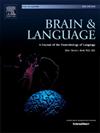The effects on tACS and tRNS on language function: A literature review
IF 2.3
2区 心理学
Q1 AUDIOLOGY & SPEECH-LANGUAGE PATHOLOGY
引用次数: 0
Abstract
Transcranial electrical stimulation (tES) techniques are promising noninvasive tools for modulating language-related neural processes. While transcranial direct current stimulation (tDCS) has been well studied, transcranial alternating current stimulation (tACS) and transcranial random noise stimulation (tRNS) remain less characterized. This review synthesizes findings from 11 studies (394 participants) investigating the effects of tACS and tRNS on language processing in neurotypical individuals. Both techniques significantly enhance phonological and semantic processing, with a moderate overall effect size, and with outcomes varying according to stimulation parameters and target regions. The effect remained significant after adjusting for potential publication bias, supporting the robustness of the findings. Prefrontal stimulation was preferentially used for enhancing phonological skills, while stimulation of both temporal and prefrontal areas influenced semantic processing. Future research would benefit from examining network-level effects, developing personalized stimulation protocols, and assessing long-term outcomes − areas that remain underexplored − to advance theoretical understanding and clinical applications.
tACS和tRNS对语言功能的影响:文献综述
经颅电刺激(tES)技术是一种很有前途的无创工具,用于调节语言相关的神经过程。虽然经颅直流电刺激(tDCS)已经得到了很好的研究,但经颅交流电刺激(tACS)和经颅随机噪声刺激(tRNS)的研究仍然较少。本综述综合了11项研究(394名参与者)的研究结果,这些研究调查了tACS和tRNS对神经正常个体语言处理的影响。这两种技术都显著增强了语音和语义加工,总体效应大小适中,结果因刺激参数和目标区域而异。在调整了潜在的发表偏倚后,效果仍然显著,支持了研究结果的稳健性。前额叶刺激优先用于提高语音技能,而颞叶和前额叶的刺激都影响语义加工。未来的研究将受益于检查网络层面的效应,开发个性化的刺激方案,以及评估长期结果(这些领域仍未得到充分探索),以推进理论理解和临床应用。
本文章由计算机程序翻译,如有差异,请以英文原文为准。
求助全文
约1分钟内获得全文
求助全文
来源期刊

Brain and Language
医学-神经科学
CiteScore
4.50
自引率
8.00%
发文量
82
审稿时长
20.5 weeks
期刊介绍:
An interdisciplinary journal, Brain and Language publishes articles that elucidate the complex relationships among language, brain, and behavior. The journal covers the large variety of modern techniques in cognitive neuroscience, including functional and structural brain imaging, electrophysiology, cellular and molecular neurobiology, genetics, lesion-based approaches, and computational modeling. All articles must relate to human language and be relevant to the understanding of its neurobiological and neurocognitive bases. Published articles in the journal are expected to have significant theoretical novelty and/or practical implications, and use perspectives and methods from psychology, linguistics, and neuroscience along with brain data and brain measures.
 求助内容:
求助内容: 应助结果提醒方式:
应助结果提醒方式:


